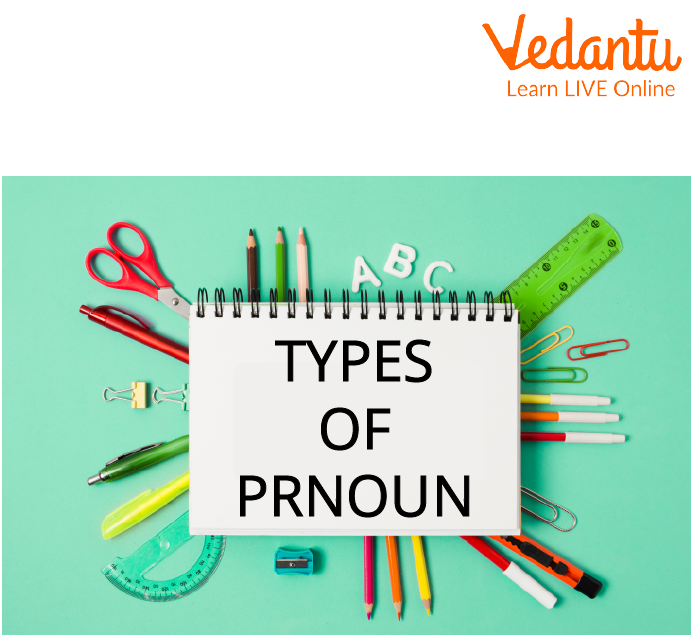English Grammar Class 5 Pronoun and its Kinds for Class 5 – Download Free PDF
Do you know what a pronoun is? Do you get confused about its multiple kinds and struggle to differentiate them? Then don’t get worried. In this article, we will discuss the pronoun and its kinds for class 5 in detail.
The pronoun refers to a word that is generally used in the place of a noun or sometimes a noun phrase, like ‘he’, ‘she’, and ‘them’ are pronouns that are used instead of a particular name. In the English grammar project for class 5 if your topic is the pronoun and their kinds then this article will be very helpful for you.
There are 6 Types of Pronouns. They Are:
Personal Pronouns: Pronouns that are used instead of a proper name.
Examples: He, She, You, I, They.
Possessive Pronouns: Pronouns that show possession.
Examples: Yours, Mine, theirs, her, his.
Interrogative Pronouns: Pronouns that are placed in a sentence for asking a question.
Example: Who, Where, What, Why.
Demonstrative Pronouns: Pronouns that are used for pointing to particular objects.
Example: This, Those, These, That.
Reflexive Pronouns: Pronouns that refer back to or reflect the subject of the sentence.
Example: Himself, Herself, Yourself, Myself.
Relative Pronouns: Pronouns that are placed in a sentence to relate one section of the sentence to another.
Example: Whom, Where, What, When.
English Grammar for Class 5 Pronoun and Its Kinds Download Free PDF
In this article, we will discuss Pronoun and their different kinds. A pronoun is a word that is used instead of a noun or noun phrase. Pronouns refer to either a noun that has already been mentioned or to a noun that does not need to be named specifically.

Introduction to Pronouns
Kinds of Pronoun:

Types of Pronouns
There are ten kinds of pronouns. They are
1. Relative Pronouns: Pronouns that relate one component of the phrase to another are known as relative pronouns. The relative pronouns that, which, where, when, why, what, whom, and whose are a few examples.
Example:
Sheena, who is a dancer, now also teaches at a University.
My bike, which I lost last month was found in an old garage
The youngster who earned the reward is shown here.
2. Possessive Pronouns: Pronouns that indicate possession are known as possessive pronouns. The possessive pronouns mine, yours, his, her, theirs, and its are a few instances.
Example:
Why did you take my dress?
This is your car.
3. Reflexive Pronouns: Pronouns that relate back to the sentence's subject are known as reflexive pronouns. Myself, yourself, herself, himself, oneself, itself, ourselves, themselves, and yourselves are a few examples of reflexive pronouns. Self or selves is used with the pronoun in this form as a suffix.
Read the sentences that follow.
I blame myself for my failure.
In our sleep, we frequently chat to ourselves.
The pronouns I, we, you, yourself, he, she, they, and themselves behave like verbs' objects, but they refer to the same people as the verbs' subjects. They are therefore known as reflexive pronouns.
4. Demonstrative Pronouns: Demonstrative pronouns are those that are employed to point at the things they are referring to. Pronouns that point to particular things are referred to as demonstrative pronouns. The demonstrative pronouns this, that, these, and those are a few instances.
Examples:
These oranges are rotten.
Those buildings are new.
This is my bottle.
That is your phone.
The words this, these, that, and those are used to identify the object or objects in the aforementioned statements. That and those allude to items lying far away, while this and these refer to things nearby. They are, therefore, called Demonstrative Pronouns.
5. Interrogative Pronouns: Pronouns that ask questions are called interrogative pronouns. Interrogative pronouns include who, what, when, why, and where are a few examples. The pronouns known as interrogative pronouns are used to ask questions about people or objects.
Examples:
Who was the noisemaker?
What is the problem?
The pronouns who, whom, and whose are used when referring to people. The pronoun is used to inquire about individuals or objects.
6. Indefinite Pronouns: Pronouns that are indefinite do not specifically refer to any one person, place, or thing. Someone, someone, someplace, something, anyone, anyone, anywhere, anything, no one, nobody, nowhere, everyone, everybody, everywhere, everything, each, none, few, and many are a few examples of indefinite pronouns.
Example:
Only a few people came to the show.
Is there anyone who still needs to register?
I did not see her anywhere.
7. Personal Pronouns: Pronouns that are used in place of people, animals, or things are known as personal or possessive pronouns. These are of three types representing the first person, second person, and third person.
Pronouns of the First Person are those that allude to the speaker or speakers; examples are I, we, me, us, mine, and ours.
Pronouns of the Second Person, like you and yours, are those that allude to the person or people being talked to.
He, she, him, his, her, hers, they, them, theirs, and it are examples of third-person pronouns that refer to the subject of the sentence.
Example:
It is not sufficient for them.
Will they buy a gift for her?
Simple pronouns called personal pronouns are used to replace proper names. I, you, he, she, we, and they are some examples of personal pronouns, as are him, her, he, she, us, and them.
8. Subject Pronouns: The action of a sentence is carried out by subject pronouns. The subject pronouns I, you, we, he, she, it, they, and one are a few examples.
Example:
I am fond of her.
He is very kind.
You are being rude.
9. Object Pronouns: Pronouns that receive the action in a sentence are called object pronouns. The object pronouns me, us, him, she, and them are a few instances.
Example:
Please allow them to come in.
After the movie, she decided to go to the beach
10. Reciprocal Pronouns: Pronouns that express a reciprocal relationship are referred to as reciprocal pronouns. Both each other and one another are reciprocal pronoun examples.
Example:
The mother and daughter looked at each other and laughed hysterically.
The siblings are kind to each other.
They recited the speech to one another.
Point to Remember:
Note: Emphatic Pronoun and Reflexive Pronouns look identical but Emphatic Pronouns are used directly after the subject while Reflexive Pronouns are used in place of the object. |
Person | Subject Pronouns | Object Pronouns | Possessive Pronouns | Reflexive Pronouns |
1st Singular | I | Me | Mine | Myself |
2nd Singular | You | You | Yours | Yourself |
3rd Male | He | Him | His | Himself |
3rd Female | She | Her | Her | Herself |
3rd Object | It | It | Its | Itself |
1st Plural | We | Us | Ours | Ourselves |
2nd Plural | You | You | Yours | Yourselves |
3rd Plural | They | Them | Theirs | Themselves |
Practice Questions
Choose the Correct Option:
I want to talk with Sam. Is _______ available at this moment?
she
He
Her
Am
Tony is as smart as __________ is.
I
me
she
we
The dog chewed on __________ favorite toy.
it’s
it is
its’
its
It could have been __________ .
Jerry
anyone
better
more difficult
Jerry is taller than __________.
I
me
she
we
Answers
The correct answer is option B. I want to talk with Sam. Is he available at this moment?
The correct answer is option C. Tony is as smart as she is.
The correct answer is option D. The dog chewed on its favorite toy.
The correct answer is option B. It could have been anyone.
The correct answer is option Jerry is taller than me.
Benefits of Learning the Pronoun and Its Kinds
The 5th class English Grammar NCERT book has a chapter called the pronoun and its kinds. Learning pronouns is very important for every person as pronouns are the critical parts of the word construction.
Pronouns are an important part of the sentence as they represent the noun in a sentence when needed.
Pronouns help to understand the sense of gender. For example: if you want to refer to the female gender you will use pronouns like she, her, or herself. On the other hand, if you want to refer male gender you will use pronouns like he, him, or himself.
Examples of Pronouns
Example of demonstrative pronoun: This is my ball. Here, the word ‘this’ is a demonstrative pronoun as it is pointing out the ball.
Example of relative pronoun: Gita, who is a teacher, is my elder sister. Here, the word ‘who’ is a relative noun.
Example of reflexive pronoun: I make this clay pot myself. Here the word ‘myself’ is a reflexive pronoun.
Facts About Pronoun and Its Kinds for Class 5
There are different forms of pronouns which are discussed below:
Different Forms of the Personal Pronouns
Parts of Speech | First Person | Second Person | Third Person | |||
Singular Form | Plural Form | Singular Form | Plural Form | Singular Form | Plural Form | |
Possessive | Mine, My | Ours, Our | Your | Your | Her, Him | Theirs, Their |
Subject | I | We | You | You | He, She | They |
Object | Me | Us | You | You | He, She | They |
Different Forms of Interrogative Pronoun
Case | Person | Objects or Animals |
Possessive | Whose | |
Objective | Whom | What |
Nominative | Which, Who | What, Which |
Important Topics of Pronoun for Class 5
In this chapter you will learn:
What are pronouns and where to use them in a sentence.
Different types of pronouns and their usage.
Identify the proper pronouns for different types of nouns.
Class 5 English Grammar Chapter 5 Free Download
Download the free PDF consisting of explanations and exercises of Pronouns from Vedantu’s website.
The free PDF will help you to easily understand the different types of pronouns and where to use them.
The PDF also contains pronoun tests for class 5 which will help you to practice the chapter.
The subject experts at Vedantu have given a detailed discussion on the pronoun chapter and its various types are discussed with examples. The whole explanation of the chapter is very detailed and helps students of class 5 to understand the pronoun and its different kinds very smoothly.
Summary
In this chapter, we learned the pronouns which is a word or phrase that stands in for a noun or noun phrase. Since pronouns are compact words that can serve all of the purposes of nouns, they are one of the fundamental building blocks of sentences. In order for us to speak with one another, pronouns are necessary. However, pronoun communication is really important. Next time, think twice before assuming that someone is referring to someone by their pronouns because we use pronouns to identify or refer to them.
FAQs on English Grammar Class 5 – Pronoun and Its Kinds
1. What is the need for using pronouns in a sentence?
Pronouns are used in a sentence instead of a noun. Pronouns make a sentence smoother and clearer.
2. How can you differentiate pronouns from nouns?
A noun names someone or something. A noun can be a thing or a person (like, Ram, Jack, Rock), but a pronoun refers to a word that is used instead of a noun (like, he, it, you).
3. What is gender pronoun?
Gender pronoun is the pronoun that refers to a person’s gender. For example, he, she, him, her. Gender pronouns like he, him refer male gender. Gender pronouns like she, her - refer to the female gender.










